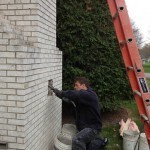Whether you heat with gas, wood, or pellets, proper airflow in your chimney is important for several reasons. Not only does it help with efficiency, but it can also prevent backdraft and fire hazards. Here are some ways you can ensure that you are getting proper airflow in your chimney.
At 2nd Generation Chimneys, our Minneapolis chimney specialists are here to answer any further questions you might have. Our technicians are trained and certified to inspect chimneys for any type of heating system that requires ventilation through a chimney, so feel free to contact us any time.
Make Sure the Damper is Fully Open
Before you turn on your heat or build the first fire in the fall, always make sure that the damper is fully open. After you open it, check to make sure it’s fully open. Often a damper won’t open all the way because of excess creosote or soot buildup on the smoke shelf, or the damper could be damaged.
Schedule Your Annual Chimney Cleaning Before the Heating Season
In addition to checking for damage to the damper or other components, hiring a professional for a thorough chimney cleaning and inspection before the weather gets cold is important for many reasons. This gives the technician a chance to clean out dangerous levels of creosote build-up, and check for other issues with airflow. Poor chimney design is another issue that can be remedied in several ways. A damaged chimney cap or animals living inside the chimney are other potential airflow blocks.
Have Your Chimney Repaired as Needed
Should you need a chimney repair, it is important to have the repairs done before you use your heating system for the first time in the fall. This ensures proper airflow and safe operation. If there are cracks in the lining or your chimney needs masonry repairs, it’s also important to have this done since moisture can damage the inside of the flue or fireplace.
Increase Airflow by Making a Hotter Fire
The draft in your chimney works by pulling the air up through the chimney, so an easy way to increase the airflow is to burn hotter fires. Because hotter air is lighter, it creates more pull. If your chimney is too short or narrow for the heating unit, it can also affect the airflow and draft.
Make Sure Your Home is Properly Sealed and Insulated
Having a home that is sealed too tightly or one that has too many cracks and air leaks can disrupt the pressure inside the home, which also affects the draft.
Call the Minneapolis heating experts at 2nd Generation for any further questions you might have.

